Antarctic Warming Is Continent-Wide BBC - January 22, 2009
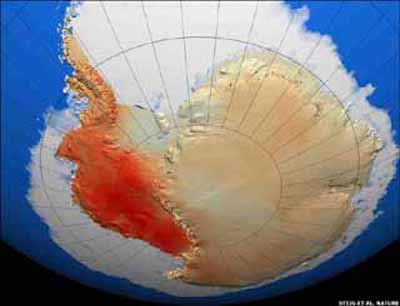
Antarctica Heating Up, "Ignored" Satellite Data Show National Geographic - January 22, 2009
Antarctic Warming Is Continent-Wide BBC - January 22, 2009

Antarctica Heating Up, "Ignored" Satellite Data Show National Geographic - January 22, 2009
 Antarctic Survey's Stunning Species National Geographic - December 2, 2008
Antarctic Survey's Stunning Species National Geographic - December 2, 2008
Huge Mountain Range Should Not Be There Live Science - October 21, 2008
15-Foot Antarctic "Salamander" Found; Was Toothy Terror National Geographic - September 11, 2008
Prehistoric Antarctic Bugs and Plants Discovered National Geographic - August 5, 2008
Fourteen million years ago the now lifeless valleys were tundra MSNBC - August 5, 2008
Antarctic Fossils Paint Picture Of Much Warmer Continent Science Daily - August 6, 2008
Rock links Antarctica and North America MSNBC - July 28, 2008
Tiny Fossils Reveal Warm Antarctic Past National Geographic - July 28, 2008
Fossil Suggests Antarctica Much Warmer in Past Live Science - July 22, 2008
Ice dam to break prematurely on Argentine glacier PhysOrg - July 8, 2008
A single boulder may prove that Antarctica and North America were once connected PhysOrg - July 17, 2008
A lone granite boulder found against all odds high atop a glacier in Antarctica
may provide additional key evidence to support a theory that parts of the southernmost
continent once were connected to North America hundreds of millions of years ago.
Ice Adrift From Warming Scrapes Antarctic Seabed Bare National Geographic - July 17, 2008
Antarctic Ice Shelf All But Lost Live Science - July 10, 2008
Antarctica 'warm as Africa' 100m years ago Telegraph.co.uk - June 19, 2008
 Ice Shelf Collapses in Antarctica National Geographic - June 17, 2008
Ice Shelf Collapses in Antarctica National Geographic - June 17, 2008
Ancient Mammal Relative Dug Burrows in Antarctica? National Geographic - June 10, 2008
Fossilized Burrows 245 Million Years Old Suggest Lizard-like Creatures In Antarctica Science Daily - June 9, 2008
New Early Triassic mammal-like reptile, Thrinaxodon, Fossils Suggest
Ancient Cat-sized Reptiles in Antarctica Live Science - June 8, 2008
New Early Triassic mammal-like reptile, Thrinaxodon, Fossils Suggest Ancient Cat-sized Reptiles in Antarctica Live Science - June 8, 2008
Antarctic Ice Causes Glacial 'Earthquakes' Live Science - June 7, 2008
These ice-driven seismic waves had the force of a magnitude 7 earthquake.
"Brittle Star City" Found on Antarctic Seamount National Geographic - May 20, 2008
Giant, Unknown Animals Found off Antarctica National Geographic - March 29, 2008
"Mountains of the Moon" Glaciers Melting in Africa National Geographic - March 26, 2008
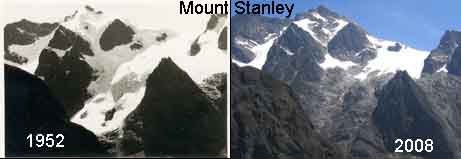
Giant Antarctic Ice Shelf Collapses National Geographic - March 26, 2008

A chunk of Antarctic ice about seven times the size of Manhattan
suddenly collapsed, putting an even greater portion of glacial ice at risk.
 Video: Antarctica Ice Collapses National Geographic - March 27, 2008
Video: Antarctica Ice Collapses National Geographic - March 27, 2008
Huge Iceberg Splits In Southern Atlantic Ocean Science Daily - March 17, 2008
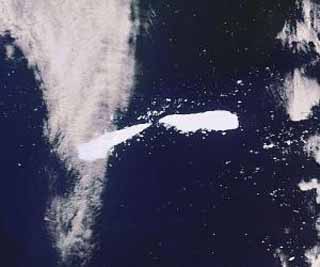
West Antarctic Glaciers Melting At 20 Times Former Rate, Rock Analysis Shows Science Daily - March 3, 2008
Under-Ice Volcano Eruption Spewed Ash Over Antarctica National Geographic - January 21, 2008
Ancient Antarctic eruption noted BBC - January 21, 2008
Scientists have found what they say is the first evidence
of a volcanic eruption under the Antarctic ice sheet.
New Dinosaur Discovered in Antarctica Live Science - December 11, 2007
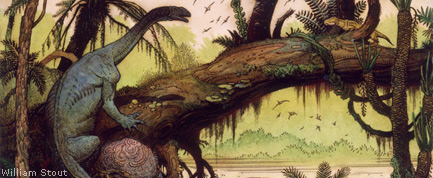
NASA Unveils New Hi-Def Map of Antarctica Live Science - November 27, 2007
White Continent in its full glory BBC - November 27, 2007
Antarctic Icebergs Teeming With Life, Study Says National Geographic - June 22, 2007
Bizarre New Deep-Sea Creatures Found Off Antarctica National Geographic - May 17, 2007
Antarctic 'treasure trove' found BBC - May 17, 2007
From beneath Antarctica's Ross Sea, scientists retrieve pristine record of the continent's climate cycles PhysOrg - April 16, 2007
Strange New Creatures Found in Antarctica (images included) Live Science - February 26, 2007
Antarctic marine explorers reveal first biological changes after collapse of polar ice shelves PhysOrg - February 26, 2007
Chain of Cascading Lakes Discovered Under Antarctica
National Geographic - February 16, 2007 Antarctic water world uncovered BBC - February 15, 2007
Giant "blisters" containing water that rapidly expand and
contract have been mapped beneath the Antarctic ice sheet.
Baby Dinosaur Buried by Volcano Live Science - December 11, 2006
A massive volcanic blast may have killed and preserved a baby dinosaur,
whose skeleton, one of the most complete example of its kind ever found,
was recovered from the frozen ground of Antarctica.
Baby plesiosaur bones found in Antarctic China View - December 13, 2006
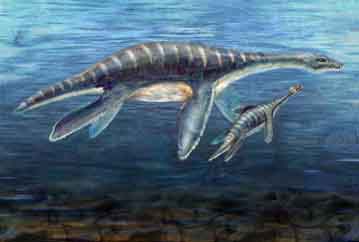
Alaskan storm cracks giant iceberg to pieces in faraway Antarctica PhysOrg - October 2, 2006
Mother-of-pearl clouds float over Antarctica National Geographic - August 1, 2006
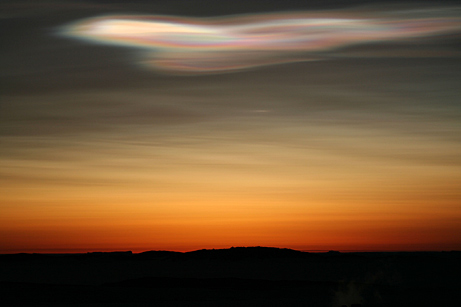
'Warm' species invading Antarctic BBC - June 24, 2006
Scientists are calling for action to prevent foreign species from taking
hold in Antarctica and wrecking the continent's unique ecosystems.
Giant Crater Found: Tied to Worst Mass Extinction Ever Space.com - June 2, 2006
Largest Ever Killer Crater Found Under Ice in Antarctica PhysOrg - June 2, 2006
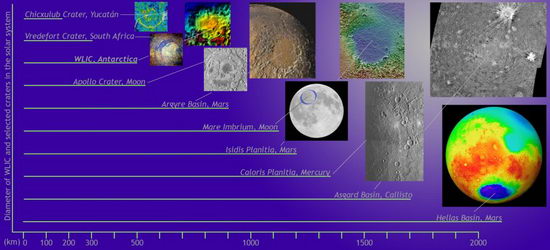
Size comparison of large craters of the solar system
Under-Ice Lakes in Antarctica Linked by Buried Channels National Geographic - April 20, 2006
Buried under Antarctica's miles-thick ice sheet, more
than a hundred lakes are dotted around the continent.
Now, for the first time, scientists are connecting the dots.
Secret rivers found in Antarctic BBC - April 20, 2006
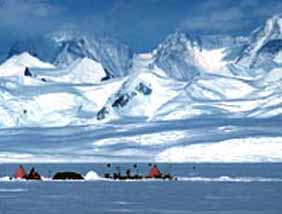
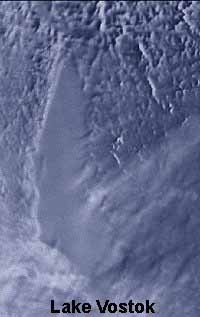
Scientists have found huge, powerful rivers that may
connect subglacial lakes deep under the Antarctic ice.
Antarctic glaciers show retreat BBC - April 2005
Pile-up as berg hits Antarctica BBC - April 2005
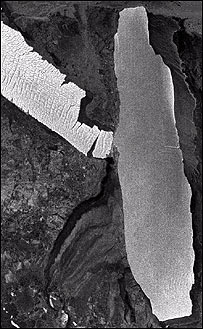
Researchers Find Moon Rock in Antarctica Space.com - December 2004
New Martian Meteorite Found In Antarctica Science Daily - July 2004
New Map Reveals Hidden Features Of Ice-buried Antarctic Lake Science Daily - July 2004
Two Distinct Ecosystems May Exist
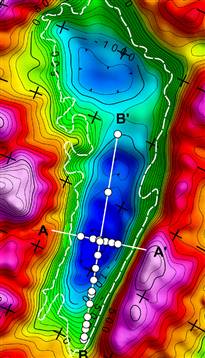
Lake under Antarctica ice may be divided MSNBC
Active Volcano in Antarctic Sound Discovered
May 10, 2004 - AP
A previously unknown underwater volcano has been discovered off the coast of Antarctica, the National Science Foundation said. The finding helps explain mariners' historical reports of discolored water in the area, the agency said. Material from underwater volcanoes is known to cause discoloration in water over them. While large areas were colonized by submarine life, none was found on dark rock around the volcano itself, indicating that lava had flowed fairly recently. In addition, dredges recovered abundant fresh basalt, a volcanic rock. It normally would be rapidly acted upon and transformed by seawater. Highly sensitive temperature probes moving continuously across the bottom of the volcano showed signs of geothermal heating of seawater, according to the agency. The volcano stands 2,300 feet above the seafloor and extends to within roughly 900 feet of the ocean surface. It is in an area known as Antarctic Sound, at the northernmost tip of Antarctica. There is no previous scientific record of active volcanoes in the region where the new peak was discovered. The volcano is located on the continental shelf, in the vicinity of a deep trough carved out by glaciers passing across the seafloor.
Opportunity Finds Mars Rock Similar to Meteorite on Earth in Antarctica Space.com - April 2004
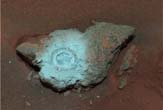
A rock in Mars' Meridiani Planum shares a mineral "fingerprint"
not with other Mars rocks that probes have seen, but with
a meteorite that smashed into Antarctica millennia ago.
Antarctica's ice sheet melting naturally January 2003 - BBC
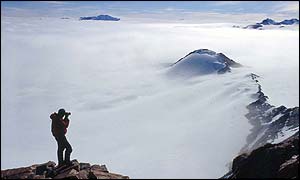
Antarctic - Lake Vida's secret water December 2002 - BBC
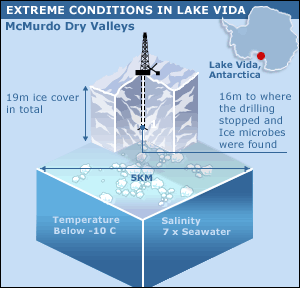
Researchers Uncover Extreme Lake - And 3000-Year-Old Microbes -
In Mars-Like Antarctic Environment December 2002 - BBC
Lake Vida may represent a previously unknown ecosystem,
a frigid, "ice-sealed," lake that contains the thickest non-glacial
lake ice cover on Earth and water seven times saltier than seawater.
Antarctic ice fringe 'melting faster' - June 2002 BBC
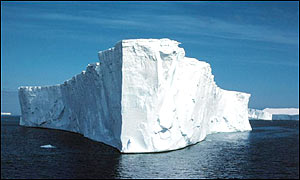
Rubbish menaces Antarctic species April 2002 - BBC
New images of iceberg breakaway BBC - March 2002
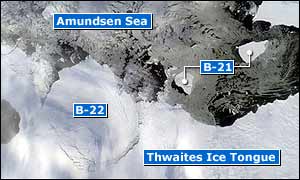
Hide-and-seek in Antarctic seas BBC - March 2002
After weeks of playing hide-and-seek in polar pack ice, the
Australian research ship Aurora Australis has successfully
retrieved scientific instruments lying for more than a year
deep in the seas off Antarctica's coast.
Bacteria found in Antarctic ice core BBC - December 10, 1999
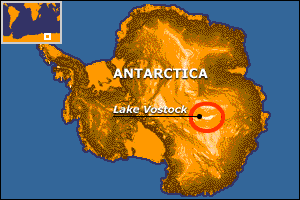

Ottawa Citizen Online - July 9, 1999
Two groups of scientists whose worksites are located as far apart as Antarctica and Jupiter's moon Europa are developing a joint research project to examine a huge freshwater lake beneath Antarctica's ice sheet. They hope to find early life forms in both places. The Antarctic lake -- the largest known in the frozen continent -- is almost as large as Lake Ontario, and twice as deep. Sandwiched between the continent's bedrock and the overlying ice sheet, it lies partly beneath Vostok Station, established by the Soviet Union in 1957. The desolate station was known as the coldest outpost of the Cold War.
A strange reflection in a single seismic record through the ice sheet in 1964 was first interpreted by scientists as a reflection from loose deposits under the ice. During the 1970s, radio-echo soundings showed the area to be large and flat, and the soundings were correctly interpreted as a sub-glacial lake. By 1994, the presence of a lake had been confirmed beyond reasonable doubt.
When scientists at NASA's Jet Propulsion Laboratory heard about the lake, they became intrigued because the surface of Europa is believed to be ice -- beneath which there could be water. The notion that liquid water might be trapped below the ice of one of the moons of Jupiter was the basis for Arthur C. Clarke's 1984 science-fiction novel 2010: Odyssey Two. NASA proposed using Lake Vostok as an experimental test site. But at this point, biologists intervened because they feared drilling through the four-kilometre ice layer would lead to contamination of the ancient waters beneath. The ice has sealed the water off from the outer world for at least one million years. Sampling the water could reveal micro-organisms in lake sediments, since Lake Vostok is presumed to have been biologically active before glaciation occurred millions of years ago. Elsewhere on ocean floors, previously unknown life forms have been found around volcanic vents. Similar conditions might be present both in Lake Vostok and on Europa.
September 16, 1999 - Reuters
Evidence of a 'lost' supernova that exploded some 700 years ago has turned up in the snows of Antarctica, New Scientist magazine said today. X-rays from the German-US orbiting Rosat satellite have shown a glowing supernova remnant just 640 light years away, suggesting the star's explosion lit up our skies at the beginning of the fourteenth century, making it by far the closest supernova in our past. But unlike other supernovas which astronomers recorded, scientists found no historical reference to this event. Then 20 years ago, analysis of an ice core in the South Pole showed four concentrations of nitrates in the snow.
Dating revealed that three of them coincided with bright supernova explosions in 1181, 1572 and 1604, which were all recorded. Now scientists say the fourth ``spike'' or concentration is the sign of the explosion pinpointed by Rosat. Its depth in the ice core corresponds to a date of around 1320, very close to the date roughly estimated from Rosat observations using theories of how supernova remnants evolve. "This fourth spike corresponds precisely with the time when light...from the recently discovered supernova would have been arriving at the Earth,'' said Kai Zuber of Dortmund University, who, along with Clifford Burgess of Montreal's McGill University, has reached the new conclusions from the evidence. The evidence from the ice core points to what astronomers call a type II supernova -- the obliteration of a colossal star 15 times as heavy as the sun.
July 13, 1999 - Reuters
Geologists have discovered the fossilized remains of massive dinosaurs in Antarctica, signs that many prehistoric "eating machines" were spread over a much broader territory than previously believed. An expedition to the remote Antarctica Peninsula and nearby islands has unearthed large deposits of dinosaur fossils, including remains of two types of large marine reptile -- mosasaurs and plesiosaurus. The leader of the expedition which unearthed them in January, Dr Jim Martin from the Museum of Geology in South Dakota, presented the group's findings at a symposium on Antarctica Earth Sciences in Wellington this week. Martin said the big surprises had been the concentration of remains found as well as evidence of great diversity of species and a much warmer climate in the polar region. The number of mosasaurs was especially striking. "Mosasaurs were just fantastic animals, some of them were up to 10 meters long, maybe more, they were armed with teeth that were three or four inches long. The skulls would easily be a meter long. "They were eating machines, that were designed to eat anything and they did."
To have revealed remains of at least four different species among the complete vertebrae, partial skeletons, whole jaws and teeth in the find was unexpected in such a remote locality. "To find a whole bunch of them like this is really surprising. We were expecting to find maybe one little bone fragment, but here were at least four different kinds of mosasaurs," he said. One type, Plioplatecarpus, is believed to have been adapted to relatively shallow water and its discovery in Antarctica suggests the continental masses were once much closer, with connecting marine corridors. "We also found a duck-billed dinosaur known as a hadrosaur on Vega Island. This was even more of a surprise. "We had always thought of them as a North American dinosaur. This suggests that North America, South America and Antarctica were connected at the end of the Age of Dinosaurs." Martin said the creatures probably came to Antarctica in the late Cretaceous period, some 75 to 80 million years ago. He said his colleagues on the expedition, Judd Case and Mike Woodburne, had hypothesized that marsupials now found in Australia actually got there from North America by travelling the length of South America, across Antarctica, and into Australia before the continents split up.
CRYSTALINKS MAILING LIST, NEWSLETTER, UPDATES